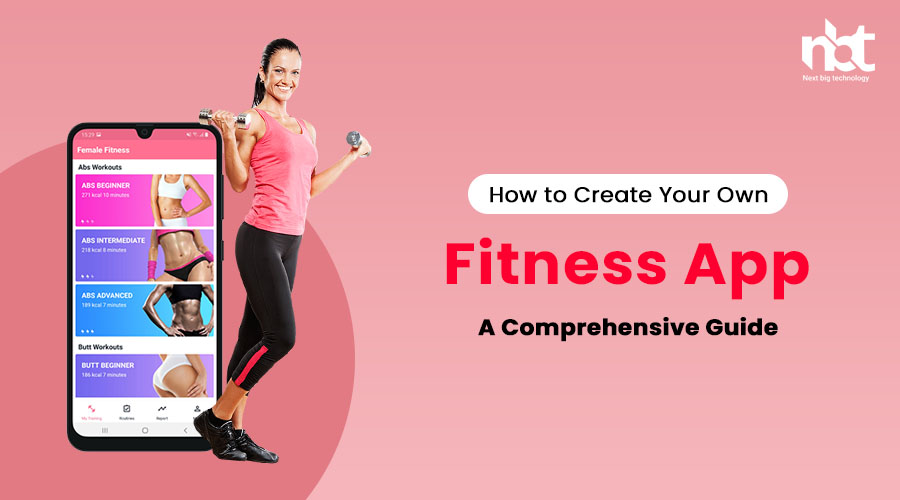Table of Contents
Introduction:
In today’s health-conscious society, fitness apps have become increasingly popular as they offer convenience, motivation, and personalized fitness experiences. If you have a passion for fitness and technology, creating your own fitness app can be a rewarding endeavor. In this comprehensive guide, we will walk you through the key steps to create your own fitness app, from conceptualization to development and deployment.
Define Your Fitness App Concept:
Before diving into the development process, it’s essential to define your fitness app concept. Consider the following aspects:
a. Target Audience:
Identify your target audience, such as fitness enthusiasts, beginners, or individuals with specific fitness goals, as this will shape your app’s features and functionalities.
b. App Focus:
Determine the primary focus of your fitness app, whether it’s workout tracking, nutrition planning, goal setting, workout routines, or a combination of these.
c. Unique Selling Points:
Identify the unique features or value propositions that will set your fitness app apart from existing ones in the market.
d. User Experience:
Envision the desired user experience and consider how your app will motivate and engage users, keeping them committed to their fitness goals.
Conduct Market Research:
Perform thorough market research to gain insights into the competitive landscape, user expectations, and industry trends. Consider:
a. Competitor Analysis:
Analyze existing fitness apps to understand their strengths, weaknesses, and areas for improvement. Identify opportunities to differentiate your app.
b. User Feedback:
Seek feedback from potential users through surveys or focus groups to understand their pain points, preferences, and desired features in a fitness app.
c. Industry Trends:
Stay updated with the latest trends in fitness technology, such as wearable devices, integration with fitness trackers, or virtual training experiences.
Outline App Features and Functionalities:
Based on your concept and market research, create a comprehensive list of features and functionalities that your fitness app will offer. Common features include:
a. User Registration and Profile:
Allow users to create personalized profiles, set fitness goals, and track their progress over time.
b. Workout Tracking:
Provide features to log and track workouts, including exercise routines, sets, repetitions, and intensity levels.
c. Exercise Library:
Include a library of exercises with instructions, images, and videos to guide users in performing workouts correctly.
d. Nutrition Planning:
Offer tools for meal planning, calorie tracking, and nutritional guidance to help users maintain a balanced diet.
e. Progress Tracking and Analytics:
Provide visual representations of user progress, including statistics, charts, and reports to keep users motivated and informed.
f. Social Features:
Implement social features like community forums, social sharing, and leaderboards to foster engagement, competition, and accountability among users.
Design the User Interface (UI) and User Experience (UX):
Create an intuitive and visually appealing UI/UX design that aligns with your fitness app’s concept and target audience. Consider the following design principles:
a. Simplicity and Clarity:
Keep the design clean, uncluttered, and easy to navigate, ensuring a seamless user experience.
b. Visual Appeal:
Use visually appealing graphics, colors, and typography that resonate with your target audience and create a positive emotional connection.
c. Consistency:
Maintain consistency in design elements, layouts, and interactions throughout the app to enhance usability and familiarity.
d. Accessibility:
Ensure your app is accessible to users with different abilities by adhering to accessibility guidelines and providing adjustable font sizes and color contrast options.
Choose the Right Technology Stack:
Selecting the appropriate technology stack is crucial for the development of your fitness app. Consider the following factors:
a. Platform:
Decide whether you want to develop a native app for a specific platform (iOS or Android) or opt for cross-platform development using frameworks like React Native or Flutter.
b. Backend Development:
Choose a suitable backend technology, such as Node.js, Ruby on Rails, or Django, to handle data storage, user authentication, and API integration.
c. Database:
Select a database management system (DBMS) that aligns with your app’s requirements, such as MySQL, PostgreSQL, or MongoDB.
d. APIs and Integrations:
Research and integrate relevant APIs, such as fitness tracker APIs or nutrition data APIs, to enhance the functionality and user experience of your app.
Develop and Test Your Fitness App:
With the design and technology stack in place, proceed with the development and testing phase. Follow these steps:
a. Frontend Development:
Develop the user interface, implement the desired features, and ensure smooth navigation and responsiveness.
b. Backend Development:
Build the server-side components, database integration, and API connections to support the app’s functionality.
c. Testing and Quality Assurance:
Conduct rigorous testing to identify and fix any bugs, usability issues, or performance bottlenecks. Perform functional testing, usability testing, and compatibility testing on various devices and platforms.
Deploy and Market Your Fitness App:
Once your fitness app is developed and tested, it’s time to deploy it to the app stores and start marketing it to your target audience:
a. App Store Submission:
Follow the guidelines provided by the respective app stores (such as Apple App Store and Google Play Store) to submit your app for review and approval.
b. App Store Optimization (ASO):
Optimize your app store listing with compelling descriptions, relevant keywords, and attractive visuals to increase visibility and downloads.
c. Marketing and Promotion:
Create a marketing strategy that includes social media campaigns, influencer partnerships, content marketing, and targeted advertising to reach your target audience.
d. User Feedback and Iteration:
Encourage user feedback and reviews to gather insights for further improvements and updates. Continuously iterate and enhance your app based on user feedback and changing market trends.
Conclusion:
Creating your own fitness app can be an exciting and rewarding journey. By following these steps, you can turn your fitness app concept into a reality. Remember to thoroughly research your target audience, analyze the market, define your app features, design an intuitive UI/UX, select the right technology stack, develop and test your app meticulously, and deploy it with a well-thought-out marketing strategy. With dedication, ongoing improvement, and a focus on user experience, your fitness app has the potential to make a positive impact on people’s health and wellness journeys.










